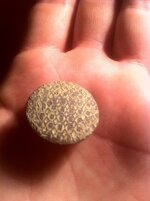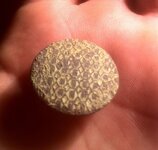Wrecker58
Jr. Member
- Oct 27, 2010
- 74
- 30
- Detector(s) used
- minelab explorer xs
minelab ctx3030
garrett pin pointers
- Primary Interest:
- All Treasure Hunting
...I have recently been trekking through miles of rural woods trying to locate a rev skirmish site...after many hours i finally started locating musket balls; at the end of the hunt i located this beautiful button with the shank still attached. I haven't had any luck identifying the design on the front of the button- appears to me as a snake skin design-there are NO markings on the backside either. Any help would be greatly appreciated; thanks for looking----sorry about how large the image is-im still learning how to upload photos through gnu image program
-cj
-cj




 As far as the metals go i believe this resembles the tombac metal you speak of. once again i do appreciate you help- cj
As far as the metals go i believe this resembles the tombac metal you speak of. once again i do appreciate you help- cj ...you sure do have alot of information for a sleepy edistonian-
...you sure do have alot of information for a sleepy edistonian-  jk...yea now that you say that i believe i have found an old home site. I went over the weekend and found a whole mess of square nails and random iron junk. Enough iron junk to drive me crazy.... I reckon there has been quite a bit of fowl hunting in this area over the years as well. Hows edisto treating you? well i hope.-there's enough history out there to keep one occupied thats for sure. Im getting ready to go to my best friends property out there at brick house plantation (just got the green light from him). Great area for hunting; if your interested i could definitely use a partner-especially one who can i.d stuff very well- thanks for your post -cj
jk...yea now that you say that i believe i have found an old home site. I went over the weekend and found a whole mess of square nails and random iron junk. Enough iron junk to drive me crazy.... I reckon there has been quite a bit of fowl hunting in this area over the years as well. Hows edisto treating you? well i hope.-there's enough history out there to keep one occupied thats for sure. Im getting ready to go to my best friends property out there at brick house plantation (just got the green light from him). Great area for hunting; if your interested i could definitely use a partner-especially one who can i.d stuff very well- thanks for your post -cj